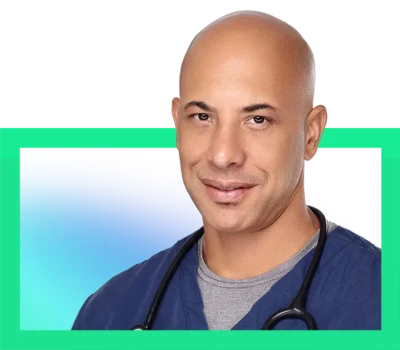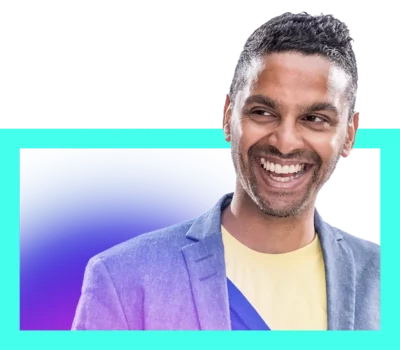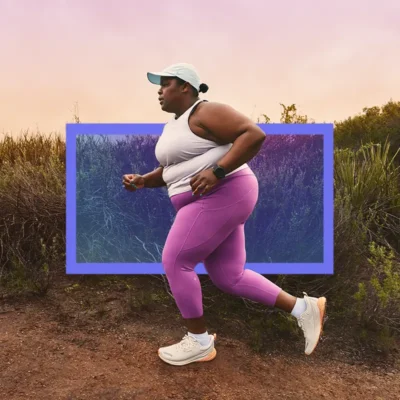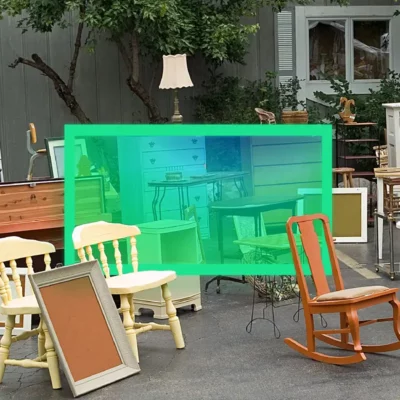Rediscover the roots of your joy
CNN’s 2023 Hero of the Year, veterinarian Dr. Kwane Stewart, has long had a passion for helping animals. Yet when a difficult work environment leaves him entirely depleted, he starts to consider walking away from his profession forever. It’s only when an unexpected encounter reminds him to return to the fundamentals, that he rediscovers the magic of his craft.
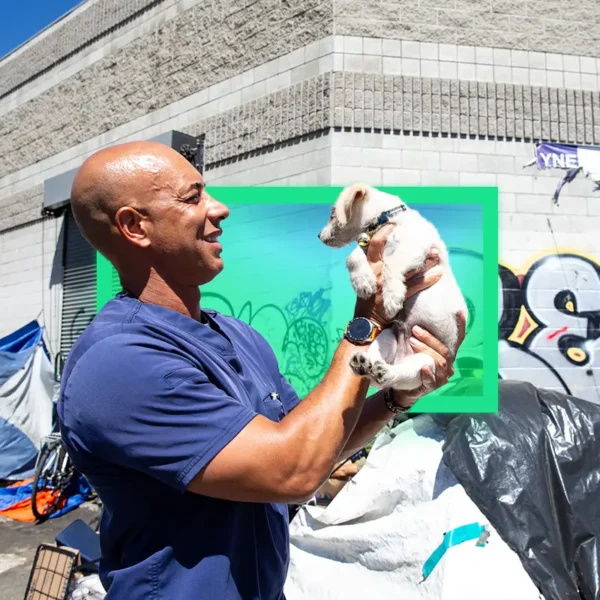

Table of Contents:
Transcript:
Rediscover the roots of your joy
DR. KWANE STEWART: When you’re diagnosing animals, you’re working with limited information. The animal can’t talk. They can’t tell you what’s wrong. It’s like solving a tiny mystery. But I’m determined to figure this out.
ROHAN GUNATILLAKE: Long before CNN named Dr. Kwane Stewart as their Hero of the Year, he was a young veterinarian with a passion for helping animals. In today’s episode, he tells the story of one of his toughest career moments, when he finds himself in a work environment that leaves him entirely depleted. Right when he’s considering walking away from his profession forever, an unexpected encounter reminds him that he can always return to the fundamentals of what he loves, and rediscover the magic of his craft.
In this series, we combine immersive first-person stories, breathtaking music, and mindfulness prompts so that we may see our lives reflected back to us in other people’s stories. And that can lead to improvements in our own inner lives.
From WaitWhat, this is Meditative Story. I’m Rohan, and I’ll be your guide.
The body relaxed. The body breathing. Your senses open, your mind open, meeting the world.
DR. STEWART: I grab an empty seat away from everyone and scan the half-filled auditorium. My student badge hangs from a lanyard around my neck. My thick orientation packet sits in my lap. A quiet hum fills the room. Everyone’s excited. Nervous. Awkward.
A man walks out onto the stage. He’s in his late sixties, maybe early seventies. Dressed in a suit and tie like a classic gentleman. Without much of an introduction, he jumps into a speech.
“I know you’ve all been working your entire lives to get to be sitting right here,” he says. This, I learn, is the dean of my veterinary school here at Colorado State University. Dean Voss. This, is day 1.
Hearing his words, I nod. Immediately captivated. He’s describing me.
I’ve loved animals since I was three. When kids in elementary school make fun of me, spending time alone with my dog — our doberman — makes me feel comforted. Makes me feel ok to be myself. The relationship between a pet lover and their pet is something special.
And when my dog gets sick, I go with my mom to the vet clinic. I sit, wide-eyed, watching the doctor slowly examine our sweet, gentle doberman. Listening to the heart. Touching the abdomen. Feeling. I can see his wheels turning. I’m in awe of everything he’s doing. Two to three minutes later boom! He knows the answer. It’s this magic combination of him connecting with the animal, and using science to figure out how to solve the puzzle. I’m amazed.
For years, I tell the people around me that I’m going to be a vet. I tell myself too. And I feel the pressure of following through. Not everyone in vet school graduates and I’ve come way too far to let that be me.
“You’ve been working your whole life for this moment,” Dean Voss continues. “None of you are here by accident.” He’s saying all the right things, using all the right words. The crowd is getting worked up. Any awkwardness I felt earlier is gone. This is exactly what I need to hear.
I look around the room. These are elite students from some of the best schools in the country. I was a classic slacker in undergrad. Going to class sometimes. Doing well enough on tests to get by. But here, I immediately feel different.
I have an aptitude for science. I like solving things. I like figuring out puzzles. I know it’s going to be tough. Working with the sick animals, seeing them at their lowest — it’s got to be hard. And this is just day one. The starting line. I know I have a lot to learn and a long way to go. But right now what I feel most is potential. My passion for this craft and the reasons I’m here feel clear. I’m going to be a vet.
Charts are stacked on my desk, tilting like the leaning tower of Pisa. They’re ready to fall at any moment. Textbooks serve as coasters for scattered coffee cups. I share the office with two other vets. I can never really find anything when I need to.
I’m 27 years old. Working as an associate veterinarian in San Diego, California. The case I’m working on is really tricky. Two other vets haven’t been able to crack it. It’s driving me crazy. I pore over my notes. My eyes dart quickly over lab results. Vaccine records. And medical history.
The patient is a West Highland White Terrier — a small white dog with signature pointy ears. For years, he’s been having a series of weird symptoms. Energy levels and appetite swing up and down. Vomiting. Weight loss. I’ve already examined him three different times. I run all the basic blood tests. Nothing obvious comes back.
When you’re diagnosing animals, you’re working with limited information. The animal can’t talk. They can’t tell you what’s wrong. So you have to rely on what you’re seeing and feeling. On the symptoms. And on your knowledge base.
It’s like solving a tiny mystery. And as my professor once told me, “a lot of diseases don’t read the book.” They don’t follow the traditional pathophysiological routes that we study in the classroom. But I’m determined to figure this out.
I don’t want to disappoint my 15-pound patient. It’s hard to look in his little face, knowing that he’s suffering. And I see how much the owners care about their dog.
“Dr. Stewart, the patient’s waiting,” my assistant walks in and reminds me.
“I know, I know, I just need a minute,” I tell her. I’m close to figuring this out. I’m close. I can feel it.
That’s when it clicks.
Wait a minute. Wait a minute. Wait a minute. There’s something the Westie’s owner told me during their last visit: the dog always vomits when guests come over.
I move papers around until I find the textbook I need. Different neurotransmitters and hormones are released when the body is stressed, like when strangers enter the home. Whatever is going on with the dog is impacting that stress reaction. Like a disease that affects the adrenal glands.
Moments later, I find it. Addison’s Disease The dog’s adrenal glands aren’t producing enough steroids. It makes a dog struggle to handle stressful events. The puzzle pieces come together. This is it. I’m almost sure I’m right.
Minutes later I greet the Westie and his owner in the examination room. I gently scratch behind his ears and offer him a treat, soothing him so that I can take a blood sample. The test results confirm my intuition. I can’t believe it. For three years the Westie’s been suffering and no one could figure it out. One injection later, it’s like a new dog. An almost immediate reversal.
Not all cases go your way. I learn that quickly in this job. You don’t solve every puzzle. Not every animal gets better. But at this moment, I think I have skills. I have some superpower. These hands can save a life.
This is what I love about this work. Using so many of the basics I learned in school. And yet it feels like magic. I feel like someone just shot me up with adrenaline. I make that dog better. I do that. And if I’m lucky, tomorrow, I’ll get to do it again for someone new.
GUNATILLAKE: What a beautiful victory. Appreciating and basking in the success of others is actually a skill we can work on. And the way we do that is by practicing. So let’s notice any taste of joy we might be feeling right now — for Kwane, for the Westie and for his owner — and let’s really soak into it.
DR. STEWART: The sound of barking echoes off the concrete walls. Down the concrete hallways. And into the concrete rooms where hundreds of animals cram into small spaces. The fluorescent lights buzz incessantly overhead. Stark shadows loom in this old, gray building. Outside, the fences are lined with razor wire. There’s no plants. Nothing living.
It’s 2008. I’m the lead veterinarian at a county shelter in Modesto, in Central California. This job isn’t easy. The population of abandoned pets in this city is growing fast. So many of them are sick or injured, with no one to care for them. And they all end up here. It’s the end of my first year, and I realize, with dismay, that I’ve put down more animals than I’ve helped.
In the past, I always remember the animals I treat vividly, even if I forget their owners. I’ll always remember a case. An animal’s face and name. Part of the magic for me is connecting with each animal. But the thousands of faces I see at this shelter are like a blur. The images I do remember haunt me.
At the end of the day, all I want to do is sleep. But I can’t. Going to the gym used to be my saving grace. But I lose all motivation. I isolate myself. Sit on the couch and watch TV. I feel numb. Empty. Like I’m losing a part of my soul.
This morning is particularly hard. We lose so many animals today, and it’s not even 10AM. We can’t save all of them. Some are too aggressive. Some are too sick. The shelter’s often overcrowded, causing disease and daily fights. I put on a strong face for my team. I have to. But I’m nearing a breaking point.
“I’m going to go get some coffee,” I tell the assistant vet. She nods vacantly.
I walk down the hall alone, to the furthest kennel that’s usually empty. My head hangs, I focus on placing each foot in front of the other. I hear incessant barking. Howling. Whining. It fills the shelter all day, every day. I can’t help but think how did I get here?
After my wife and I divorce, she moves back to her hometown in Central California. I want to be near our son. He’s still just a baby. So I follow them. At this point I’ve spent years as a professional vet in Southern California, working mainly in private practice. I still enjoy the work, but the rhythms have become a little monotonous. That excitement I had fresh out of vet school starts to fade. I start working at this shelter because they haven’t had a vet in three years and they’re desperate, so I offer help. But this work I have to do here…is an entirely different beast.
At the end of the hall, I let out and leash a pitbull from one of the cages nearby. We sit on the floor. Together. I stroke the white patch of fur that runs from his neck to his tummy with one hand, and the top of his back with another. He nuzzles me gently. The world around us, full of pain and loss, retreats a little.
We’re doing something important here. We’re going to be okay. I’m not going to let the system beat me.
These words are how I talk myself off the ledge. Until I’m back on it. Then off. Then on. Today, for some reason, I can’t seem to get off the ledge. My words aren’t helping. Each breath I take is heavy, like I’m sitting in a steam room.
As I hug this pitbull I let myself feel everything I’ve been hiding from. Maybe I’m not cut out for this. Maybe I need to move on. My reserves are tapped out. The sense of optimism I feel about my future as a vet, the sense of confidence I have in my ability to keep treating animals is gone.
I’m not myself. How can I be when the work I’m doing is so far removed from what I dreamed of as a kid? So far from the basics of care I was taught? What I’ve always loved is connecting with animals, and drawing from my knowledge of science and medicine to solve the puzzle of how to help them. How can I get back to that?
I just want to be happy, to help animals without feeling so hurt myself. All I want is to go back to those moments five years ago when I was just out of school. When I could feel that passion and that joy for what I do.
Outside of the 7/11, an older homeless man in a hoodie and jacket sits in his usual spot. He’s bundled up, except for his exposed hands. They’re cracked from the cold with faint streaks of dirt. I see him almost every time I come here. I usually walk past him. Modesto has been hit hard by the housing crisis. It’s never been great here, economically speaking. But the recession has made it awful; so many people are suffering.
But today, I stop.
I’m about to finish up my third year at the shelter. And earlier today, I start to write my resignation letter in my head. It’s all become too much. I’m going to quit. Not just the shelter. I’m going to stop being a vet altogether. I’m so exhausted, so disenchanted with the work, that the thought of returning to regular veterinary care doesn’t even occur to me.
The homeless man sits on the ground. He’s not much older than me. I see his dog curled up beside him. She rests on a jacket laid out as a bed. She’s around 65 pounds — a mix of pitbull and either terrier or lab. Her eyes are tired, defeated. Her tail wags slowly. My gaze moves from her eyes to the back of her fur coat. The hair on her rear is almost gone. Her skin is thickened and bumpy.
I slowly approach the man. My only thought is, this is a patient. Like any other patient. A pet with a problem. The dog cowers. Scared.
“My name is Dr. Stewart and I’m a veterinarian,” I say to the man. “Can I take a closer look? I think I can help.”
The man signals yes. But the dog pulls away. I hear the man say, “It’s okay. You’re okay. It’s okay. You’re okay.” I hear kindness. Compassion. I hear love.
I squat down and take a closer look. I instantly know what’s wrong. I don’t need to run any tests or consult a textbook.
“This is a flea allergy. Super easy to fix. I’ll be back soon, I promise.”
The next day, I return with the treatment. It’s a simple pill, just $3 out of my pocket. A few days later, I’m back again to check on my new patient.
The dog rushes up to greet me. Her tail sprints back and forth, she jumps to put her paws on me.
Her owner tries to calm her down. “Don’t jump on him. Be respectful.” But no warning can hold back the vibrant personality of this sweet dog. She’s full of so much joy. She runs around in little circles. She looks like a fish flopping on shore. A totally different dog.
The man is so appreciative, so grateful: “Thank you. Thank you. Thank you.” He tears up.
I’ve treated and saved thousands of animals for paying clients. I’ve heard thousands of thank yous, received cards from grateful owners. But this exchange of emotion feels different. Powerful.
The despair on the man’s face when I meet him and the joy he has today. It’s a chasm that feels so wide, a chasm I help bridge with ten minutes of my time and $3 out of my pocket. I transform the life of this animal and her owner. I remember what this feels like. The rush of adrenaline that comes from solving a case. Using my skills and knowledge. Seeing the result.
I know right away that I’m going to keep doing this. My decision is immediate. I need to go find another case like this. And another. And another.
I still believe my work in the shelter is important. Those animals deserve care and love as much as anyone. But this work puts a lightness in my chest I haven’t felt in months. And maybe it’ll even keep some animals from ending up in the county facility.
Standing in this 7/11 parking lot, I rediscover the magic of what I love to do. I get back to the fundamentals of this type of care: An animal in need, a human who loves that animal, and a vet who can help them both.
GUNATILLAKE: It’s a simple formula. But no less beautiful or elegant for that. Can we do something similar I wonder? What would be the simple formula that summarizes what you love to do?
DR. STEWART: It’s a beautiful, warm day outside. My son, my girlfriend and I set up some basic medicines on a small foldout table. We’re in a small dirt area outside a soup kitchen parking lot. It’s my first outdoor clinic. Twenty feet away from me, people line up outside a brick building, disappear inside for a few minutes, and emerge with food.
I still don’t know exactly what I’m doing or what to call it, but I practice what I’m going to say when someone comes by. I’m a vet. I’d love to check out your animal. Free of charge of course. I’m here to help.
A man with a small dog heads toward the building and I walk over right away.
“Hey, over here!”
I guide them to our little outdoor office and begin a standard examination. The dog is immediately skeptical of me and snaps at my hand.
My son jumps five feet back, panicking. “Dad, watch out!”
“It’s okay, check this out.”
I gently restrain the dog, turn his mouth toward me, and quickly administer a vaccine. I hand him back to his owner, and see the respect on his face, like I’m a lion tamer. My son looks at me the way I looked at vets when I was his age. Like I’m Batman. A superhero. A cool guy who can magically heal animals even when they try to bite him.
A second line begins to form at our table. The man with the dog thanks me, and is about to leave when he hesitates. He turns and asks,
“I have a friend who couldn’t make it. They live under a bridge a few minutes away.” I tell the man it’s no problem. I can go to them.
By the end of the day, I treat 14 animals. 14 cases like the man and his dog outside of 7/11 and a woman living under a bridge with a sick dog. I make this new job up as I go. I lean on the most fundamental parts of my training and my love of animals. And I’ve been out finding and helping ever since. That was 12 years ago.
The cases I see are simple a lot of the time. They’re easy to diagnose and to treat, and often cost only a few dollars in supplies.
That doesn’t mean everything is perfect. There are days I go out and I hear heartbreaking stories of struggle. I come home and I have dinner with my family and I still think about that person I met on the streets. But it works out enough of the time that I feel like I can keep this going. Each win makes all the losses a little easier. I feel reinvigorated. I’m doing something important here.
It’s funny, sometimes you don’t know where you’re supposed to be until you’re actually there.
No matter what your profession, life leads us down all sorts of paths. And we sometimes drift away from things we love. Our work becomes exhausting, distressing. When that happens, it can feel like the only option is to throw it all away and start something else from scratch.
But you probably just need to sit back for a moment, and think about that window of time when you were happiest doing this work. Maybe you were fresh out of school. Or well into your best years. What did that look like? What were you doing?
When you return to those fundamentals, you can rediscover the magic that brought you to this work in the first place. And find your way out of the darkness.
Rohan’s closing meditation
GUNATILLAKE: Thank you Kwane.
Kwane’s story today was very real for me.
Our own family dog, Nessie, had a fairly rough time recently and it was all a bit touch and go but she’s made a full recovery and is as fit as an almost 12 year old dog is likely to be.
And, what’s more, I’m sure that like many of you, I’m always on the lookout for ways to maintain the connection I have to my work, especially when things get challenging.
The image that Kwane shared of him outside that 7/11, caring for the dog and its owner was such an evocative one. it allowed him to strip away all that was not The Thing, so all that was left was The Thing. Kwane doing the Thing that he loves, that energizes his whole being.
So we too will start by stripping back.
Yes there’s a lot going on in the world. Outside and inside. But just for now we can put that to one side and drop back into what it’s like to just be here.
Knowing the heaviness of our head.
The tingling in our hands.
What it feels like as the body breathes.
Stripping everything back to just what is happening right now.
The temperature of the skin on our face.
How sounds appear in our field of hearing.
Aware of our energy level.
Without judgment.
And the question I’d like us to drop into our awareness together is this:
What is the atomic unit of our universe of meaning?
Or in other words, what is the purest form of the activity which unlocks our sense of flow unlocks connection and joy in our work life?
I’m here, I’m open to what is happening in my experience.
And I drop that question in, I inquire.
And stripping it all back, I see that the atomic unit of my universe of meaning is working with others to create something delightful which makes people happier.
Yeah that feels right.
So, inspired by Kwane I’m going to work on all those three things:
- Working with others
- Creating things that are delightful
- Creating things which lead to happiness in others
My sense is that magic will happen when I put energy into these things by themselves.
And the magic will accelerate when they happen all at the same time.
So that is my pledge to myself and my pledge to you.
To energize my being, to dispel any disillusionment, by putting myself in situations where these three things can happen.
What will you pledge?
What will be the thing, the action, the situation you will seek out to reconnect with or just reinforce the fire that fuels the work you do?
Now notice your energy levels.
Aware of how it might be different to before.
And of course on behalf of my dog Nessie, we will close by bringing to mind the dogs across the world who provide companionship to people who most need companionship.
Visualizing, if you can, a dog you know who does just that.
Or just imagining one.
May you be well.
May you be happy.
May you know peace.
Thank you Kwane, for your story and for your amazing, amazing work.
And thank you.
Go well.
We’d love to hear your personal reflections from Kwane’s episode. How did you relate to his story? You can find us on all your social media platforms through our handle @MeditativeStory. Or you can email us at: [email protected].
